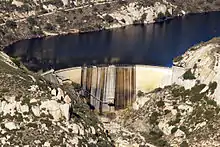Lake Hodges
Lake Hodges is a lake and reservoir located in Southern California, about 31 miles (50 km) north of San Diego and just south of Escondido, California. When full, the reservoir has 1,234 acres (4.99 km2), a maximum water depth of 115 feet (35 m), and 27 miles (43 km) of shoreline.[1] Lake Hodges has a total capacity of 30,251 acre-feet of water.[2]
| Lake Hodges | |
|---|---|
 Lake Hodges looking east with views of the 2009 pedestrian bridge, Interstate 15's Lake Hodges Bridge, and the San Pasqual Valley in the distance | |
 Lake Hodges  Lake Hodges | |
| Location | San Diego County, Southern California |
| Coordinates | 33°02′42″N 117°07′43″W |
| Type | reservoir |
| Primary inflows | San Dieguito River |
| Primary outflows | San Dieguito River |
| Basin countries | United States |
| Surface elevation | 220 ft (67 m) |
| Dam | Lake Hodges Dam |
Water level elevation in the lake is maintained at a maximum of 295 feet (90 m) above sea level, 20 feet (6.1 m) lower than the dam's maximum of 315 feet (96 m) spillway to ensure safe operations.[3] The lake level can fluctuate significantly, depending upon the amount of runoff received from the San Dieguito River drainage basin.[4]
Interstate 15 crosses Lake Hodges via the Lake Hodges Bridge. Approximately 1,000 feet (300 m) west of the I-15 freeway bridge is a bicycle/pedestrian bridge which opened on May 15, 2009 and is the longest stressed ribbon bridge in the world.[5][6]
Lake Hodges is owned by the city of San Diego, and supplies water to the San Dieguito Water District and Santa Fe Irrigation District.
Lake Hodges has been said to be the home of an alleged lake monster, known as "Hodgee".
Lake Hodges Dam
Lake Hodges Dam is a multiple-arch dam that sits on the San Dieguito River. It was commissioned by the Volcan Water Company and designed by John S. Eastwood. It was completed in 1918, and later purchased by the city of San Diego.[7] Water from the Lake Hodges Reservoir services the customers of the Santa Fe Irrigation District and the San Dieguito Water District. The dam is 131 ft tall and 729 ft wide.[8]
Recent events
In 2005, the San Diego County Water Authority, in conjunction with the City of San Diego, began work on a pipeline to connect Hodges Reservoir with Olivenhain Reservoir. The project was completed in 2012.[9] The connection provides the ability to store 20,000 acre feet (25,000,000 m3) of water at Hodges Reservoir for emergency use.
See also
- Lake Hodges Bridge
- List of dams and reservoirs in California
- List of lakes in California
References
- "Archived copy". Archived from the original on 2010-01-03. Retrieved 2009-05-18.CS1 maint: archived copy as title (link)
- "Archived copy". Archived from the original on 2010-01-03. Retrieved 2009-05-18.CS1 maint: archived copy as title (link)
- "Hodges Reservoir Water Level"
- Jones, J. Harry (May 16, 2015), "Bridge over Lake Hodges - what lake?", The San Diego Union-Tribune
- http://www.sdrp.org/projects/Lake%20Hodges%20Bridge/Lake%20Hodges%20Bridge.htm
- http://www.signonsandiego.com/uniontrib/20081128/news_1mc28bridge.html
- http://www.sandiego.gov/water/gen-info/history.shtml
- "Hodges, Lake Dam | Vay Open Data". vay.studio. Retrieved 2019-11-07.
- http://www.sdcwa.org/lake-hodges-projects
 Aerial view of the lake looking toward the west
Aerial view of the lake looking toward the west Aerial view of Lake Hodges Dam
Aerial view of Lake Hodges Dam The eastern portion of Lake Hodges in near-dry conditions in 2013
The eastern portion of Lake Hodges in near-dry conditions in 2013
External links
- Hodgee, the Lake Hodges Monster, Lake Hodges Scientific Research Center
- Hodges Reservoir - City of San Diego
- U.S. Geological Survey Geographic Names Information System: Lake Hodges
- Lake Hodges Projects, via SDCWA.org
